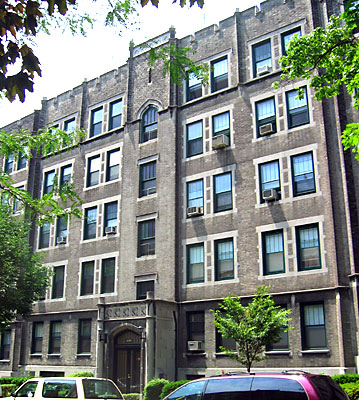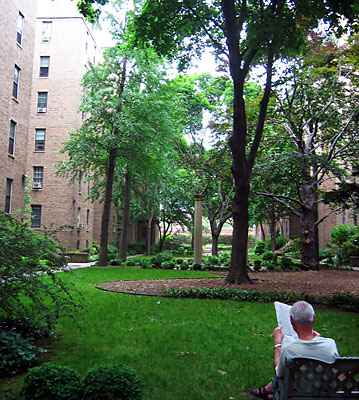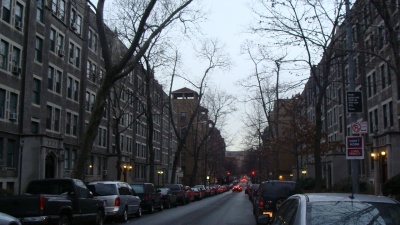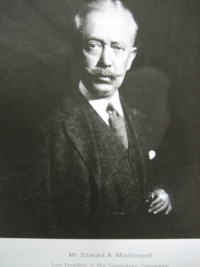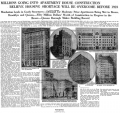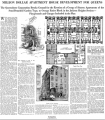Discovering 80th Street and the Community Around itFrom The Peopling of New York City
The Street: 80th Street (Between 34th and 37th Avenues)
Welcome to 80th Street...
If you take a stroll down 80th Street between 34th and 37th Avenues, in the heart of Jackson Heights’ landmarked Historical District, it would be impossible not to notice the distinct architecture of the majority of the apartment buildings on the street or the unique atmosphere the street seems to create. On a cool, breezy, sunny spring day sometime in mid-April, you will hear the rustling of leaves from the trees swaying, with birds chirping, all against the backdrop of the grandeur of 5-story Greystone buildings built in a traditional English Gothic and Tudor style, complete with little gardens in the entrances. The entire scene might seem strikingly uncharacteristic for a Queens neighborhood just a few blocks away from the main commercial distinct. Nevertheless, this street does exist; in fact, it was specifically designed to have this particular suburban feel in the middle of an urban setting. Walking towards 37th Avenue, the strictly residential area starts to commercialize. The Greystone apartments end and are replaced by newer, modern, ordinary apartments. On the intersection of 80th Street and 37th Avenue, businesses such as “Italian Farms”, “Sera Sera” (café and bakery), a local discount store (Q & Q discount) and services (Cleaners) mark the four corners. Walking in the opposite direction towards 34th Avenue, another apartment complex emerges into view; 6 stories high, and complete with private interior gardens twice the size of the co-op buildings sandwiched in between the apartment complexes on either side (80th and 81st street), the Towers apartments capture the epitome of the "Garden Apartments." Nevertheless, despite being the beginning of an important commercial spine for this block, it is the rustic Greystone and Tower apartment complexes that mark this street and make it an intriguing subject for further investigation.
The Intrigue
Erected in 1917 as the “Garden Apartments”- officially coining the term- (the name was changed to “Greystone Apartments” in 1925, since “Garden Apartments” became a name used to describe general type of apartment building), were said to the be the “first application of the garden apartment type of plan in the City of New York."[4] Many architects even consider it to be the first truly garden apartment complex in the United States. Among the first buildings of their kind, the Greystone Apartments ushered in the “Garden City” movement that would influence most of this area’s development. [5]
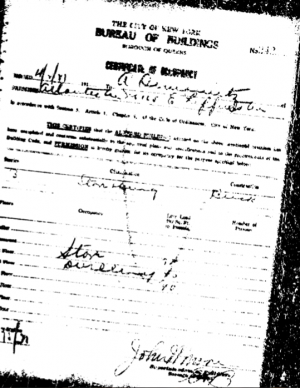 A certificate of occupancy from building 35-48 on 80th Street, a Greystone
The Story Begins...Though rapidly developing by 1917, the region around 80th street, and most of Jackson Heights, was mere swap and farmland prior to the 1900s. Known as the Trains Meadow region of Newtown, named after an old colonial road [10], 80th street and its surrounding area were still an unorganized collection of dirt roads and marshy farmland by the late 1800s, an article in the Jackson Heights News article paints a picturesque scene of the region prior to development, "barns and bee hives, carriage-houses and corn-cribs...dirt roads, packed hard by years of iron-shod hooves..." [11] . Most of the property was owned by two old established families- the descendants of Rev. William Leveriche (who settled the area in 1662) and the Barclay family (who were known for trotting horses and built a racetrack on Northern Boulevard) [12]. The turning point of development and real estate boom in this section of Queens arrived with the announcement of plans for the Queensboro Bridge in 1899, which promised to connect 59th Street in Manhattan with Long Island City in Queens. Finally ending the Borough’s road system isolation, the Bridge made Queens a reasonable commuting suburb for city workers at the very time when mass automobile production began in earnest[13] . In addition, the Pennsylvania Railroad bought the Long Island Railroad in 1900, electrified it through Queens, and connected the line to Manhattan by 1908. The rapid development and settlement of the region is evident through the increase in property value- from $6500 per acre in 1909 to $18,5000 per acre by 1918 [14]. The Queensboro Bridge opened in 1909, making Queens a highly desirable living location and therefore a real estate magnet. Unsurprisingly, these developments in transportation prompted speculative land purchases in northern Queens, and by 1901, major building had already begun. [15]  The major corporation was primary responsible for the development of the Jackson Heights area and its rapid development at the turn of the century.
The man responsible for the conception of 80th street, and that entire section (70th to 92nd street) was Edward Archibald MacDougall, the president of Queensboro Corporations, the purchaser of $3.8 million of farmland, and the visionary behind the “Garden City” movement not only on 80th Street, but the United States[17] . The 325 acres of land the corporation owned was divided into 88 blocks, 200 by 600 feet (twice the standard). Although he started construction of apartments in 1911, these buildings were common, and rather simple in design, and limited to the area close to Northern Boulevard because it was the only transportation available for the neighborhood. It wasn’t until MacDougall’s trip to Europe in 1914 when he would form his vision for Jackson Height’s development, and the arrival of the elevated subway on Roosevelt in 1917, making Grand Central a 20-minute ride away that MacDougall was able to expand. [18] Started by Ebenezer Howard to draw people out of crowded cities, the Garden City Movement was started in England in 1898. Influenced by the “Garden City” movement overseas, where it had become a popular response to the dirt and congestion in tenement occupied urban areas, MacDougall embraced the idea of a “Garden City” in Queens and implemented it rapidly. Laurel, Oban and Penryn Courts came up before it, The Garden Apartments (as they were called at the time) was the first major apartment complex the Queensboro Corporation built in area[19] . The primary goal of these new-style apartments was to provide maximum sunlight and ventilation along with interior gardens to create a natural setting in the otherwise urban and industrial city [20]. Two rows of 14 five-story Greystone Apartment houses were built facing each other, each housing 10 to 20 families. The apartments were set back from the traditional building line (12 feet back) to allow for planting trees and general parking treatments, increasing the width of the street to 84 feet (while it is 60 feet in Manhattan), and the buildings are shallow in depth in order to leave room for a large garden in the back. [21]
The Architecture The apartment units in the Greystones were designed to provide excess sunlight, air and space.
Originally called 23rd Street, the Greystone Apartments on this street were named “Operation No. 7” by the Queensboro Corporation, as they were the seventh major project the company endeavored in the region[23]. Architect Mr. George H. Wells was chosen to develop these apartments. His design was well-planned block housing, if a little simple; the floor plan shows it was wide along the front, and an ell containing the kitchens and maid’s room in the rear. The rooms were generally fair in size, but particularly had access to sunlight and good air circulation. Ironically, though being the first “Garden Apartments”, the Greystones lack what the modern sense of the word as come to mean in later apartment complexes- no interior garden court, and the windows of the rooms face the narrow street instead of the gardens[24]. Nevertheless, the Greystone Apartment buildings were carefully planned and built, like most the area, and were the first major apartment building complex of its type in the area. [25]
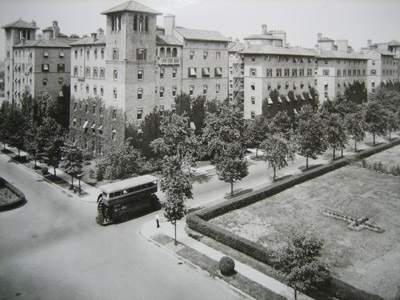
The Towers came later in 1924- as one of the eight block-long complexes built by Queensburo in the five year span from 1920-1925 [27]. Constructed by architect Andrew J. Thomas in addition to the The Chateau and Spanish Gardens, the Tower complexes are detached and include a huge interior landscaped garden [28]. Later to become the most renowned of all the garden apartments, the Towers so perfectly fit MacDougall's dream for the ultimate garden complex, he moved his own family to a 14-room duplex at the top floor of a Tower building at the corner of 80th Steet and 34th Avenue [29]. In a very literal way, the creator had become part of his own creation; however, what started off as a model of urban planning, soon began to resemble Utopian elements.
Building a Community MacDougall planned a community, not just apartment buildings; he donated land for Churches, planned the commercial district nearby on 82nd Street and 37th avenue, built playgrounds, made a golf-course and tennis courts, essentially creating a “city within a city." [31] He even published a localized paper- the Jackson Heights News- in addition to a Community Clubhouse providing leisure activities such as dancing, bowling, club meetings and a drama school started by theatrical producing Oliver Mitchell- known as Oliver Morosoco [32]- perhaps fulfilling the "self-contained" part of his overall vision. All this was undoubtedly done to attract a particular group of people to the new “Garden City”. Tenants were screened for social compatibility [33], yet ultimately, it was the money that made the final cut. By 1920 Queensboro introduced the Cooperative Ownership Plan, under this system the average cost of one apartment unit was anywhere from $18,000 to $25,000, with a few hundred dollars extra monthly charges [34]. Therefore, Queensburo brought to 80th street and Jackson Heights an affluent professional class- the high prices weeded out most potential residents, and there was a very clear understanding that only white Anglo-Saxon Protestants were welcome to this new, posh, suburb, and were the only ones Queensburo sold to [35]. These racial and religious restrictions were never advertised, but accepted quietly, as an old resident recalls, "'It was solidly white, of course...'" [36]. The company spent considerable effort and money into advertising their infant community, from their methods of advertisements to MacDougall's own comments it was fairly blatant who the company was selling to. MacDougall described his apartment as a "model that has all the advantages of the Park Avenue apartment without its weakness [density]."[37] MacDougall had no need to be subtle about his intentions- his apartments were meant to be filled with those akin to the rich and wealthy who inhabited Park Avenue.
 An historic view of several Jackson Heights' community greens and the golf course in the 1920s.
The Price of Utopia?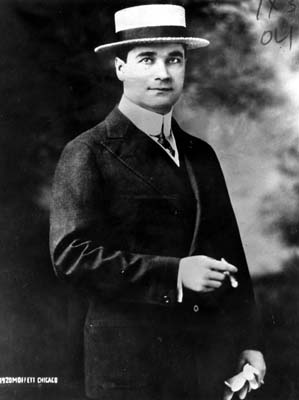 MacDougall's bias against non-white and less financially stable tenants filled his community with a very bland population, but what's a Utopia without some hidden secrets and scandal? At the center was the well-known theatrical producer Oliver Morosoco, a temporary resident in Jackson Heights, who also started a drama school at the Community Clubhouse [41]. Oliver Morosco, who's real name was Oliver Mitchell was a successful producer in Los Angeles when he came to New York City to expand his ventures around 1915[42]. His greatest hit, "Peg O' My Heart," while his first New York City presentation was "The Bird of Paradise" [43]. Well known in theatrical world, and still remembered on Broadway [44], Morosoco's presence in Jackson Heights sheds light on class of people this area attracted and the rich opportunities, resources and connections contained in this community in its early days. However, Morosco was not only in the public eye for his musical productions, involved in a copyright lawsuit over "The Bird of Paradise" for most of his career [45], he was also involved in a scandal with an actress in one of his shows, Selma Paley, who he had an affair with- his wife, Annie T. Morosco, who had been involved in financial ventures with him divorced him and sued him on the grounds that her money was being used to support Paley in a lavish $3000 apartment Morosco bought for her in the city [46]. She charged that Morosco had charged up $20,000 in losses and used money from the Oliver Morosco Company Inc., which she owned a part of, to buy Ms. Paley a house [47] ; next Morosco made the Times was when it was announced that he had married Paley in 1922 [48]. Though a fleeting bird in Jackson Heights, Morosco personality in Jackson Heights sheds light on the area's posh status and his drama school in the community center shows the extent of MacDougall's efforts to create the a community with the best of the best in services and activities available- unfortunately, he also only allowed those in who he felt were worthy of such amenities.
Difficult Times and Unexpected GeniusWhile the 1920s were the golden blooming years of 80th street and Jackson Heights' development and habituation, with building after building erected during all throughout the decade, each more successful than the last, many of the people who bought apartments doubled their money in just a few years [49], the real estate market was steaming, and 80th street was right at the center of the speculation and profits, therefore, it was also hit hard when Wall Street crashed in 1929. In the last decade, MacDougall saw his brainchild increase from a population of 3800 to 44500- a 1300% increase [50], little did he know the worst economic crisis in the nation's history was around the corner and it would stifle development, ending an almost decade long of nonstop growth and profits. Though the financial troubles took a few years to make a real impact, once they hit, they hit hard [51]. Apartments were divided into smaller units, prices fells dramatically, some, like the Towers Co-op eventually failed by 1934 and had to resort to rentals [52]. Mildred Hughes, a tenant at the time, remembers that her family moved from a $125-a-month flat to a top-floor $75-per-month apartment, but that was not the end of it, "a short time later the rent fell to just $55 per month, and then Queensboro offered to sell us the apartment for $500. But times were so difficult that we could not afford to buy it." [53].
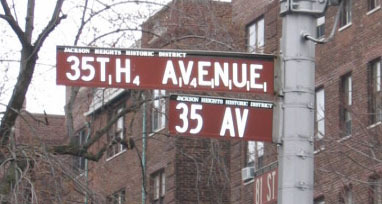 Scrabble point values added for each letter to honor the invention and its inventor
The Start of Recovery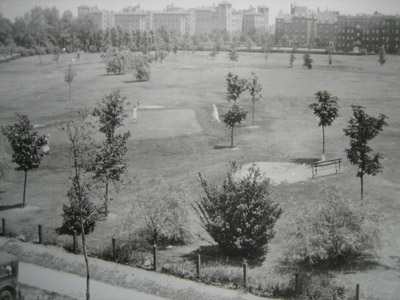 By 1935 new apartment buildings were announced to start construction, and by the end of decade dozens of buildings were underway [63]. During this era many other changes came to the neighborhood, directly affecting the residents of 80th street. In 1937 the Jackson Heights Post Office opened [64], another sign of the community's growth and maturation. In addition, during this period residents of 80th street acquired the convenience of new transportation connections- the E line on 8th Avenue and 53rd Steet, the Triboro and Whitestone Bridge, The Midtown Tunnel, Grand Central Parkway, the Brooklyn-Queens Expressway and the biggest one, LaGuardia Airport [65], now 80th street was completely linked to not only Manhattan, but had the entire world at its doorstep. Unsurprisingly, it was only a matter of time before the the white middle class suburb would have to accommodate for a more diverse population. The times were definitely changing, and as things starting to look up again, Queensboro began a new project, a block-long apartment complex, Dunnolly Gardens, the first in 13 years. However, though a reason for optimism and renewal, this complex also symbolically brought about the end of the "old Jackson Heights" [66]- built on one of MacDougall's prized community assets, the golf course. With the return of better economic conditions, the new pressures and demands for housing was starting to interfere with the original dream MacDougall had set out to create, the Dunnolly Gardens ushered in a new era for the neighborhood, while it started to chip away at original the Utopian model.
Continue the journey...Into Modern Day
Notes
|

